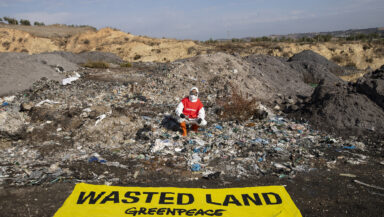Unilever is vocal about its desire to conduct business that does ‘more good for our planet and our society – not just less harm’. In recent years, it has been visible at conferences around the world, promoting its plan to use ‘less plastic, better plastic or no plastic’.
In this report, Greenpeace International investigates the reality behind these soundbites. We expose the blight of Unilever’s single-use sachets on low-income communities and the glaring gap that exists between what the company says it will do, and what it actually does.
We conclude by urging Unilever to grasp the opportunity presented by the new UN Global Plastics Treaty. The company must spearhead an industry-wide movement, one that transitions businesses away from single-use plastics and towards the adoption of at-scale reusable packaging systems around the world.
Key findings
New Greenpeace International analysis shows that:
- Despite committing to using ‘less plastic, better plastic or no plastic’, Unilever’s plastic footprint has not decreased at all. The company produced 610,000 tonnes of plastic packaging in 2017, 700,000 in 2018, 700,000 in 2019, 690,000 in 2020, reaching 713,000 tonnes in 2021, before dipping to 698,000 in 2022.
- Unilever promised to cut its virgin plastic use in half by 2025. At its current trajectory, this won’t be achieved until at least 2034.
- Unilever claims to want a ‘waste-free’ world, yet just 0.2% of its plastic packaging is currently reusable and the company has to date refused to set a reuse target.
- If the company continues increasing its share of reusable packaging at its current rate, it will be the new millennium before it fully switches over to reuse.
- Unilever is the biggest corporate seller of plastic sachets in the world, and is predicted to sell over 53 billion sachets in 2023 – 1,700 per second. Campaigns around the world have called for these sachets to be banned due to their appalling environmental and health impacts, particularly in Global South communities.
- The company first promised to tackle the problem of sachet waste in 2010. Instead, it went on to produce an estimated 475 billion over the next decade, steadily increasing sachet production by approximately 1-2 billion items a year.
- Dove, Unilever’s most profitable ‘master’ brand, generates billions of units of single-use plastic each year, including an estimated 6.4 billion sachets, accounting for over 10% of Unilever’s total sachet sales.
The report also highlights that:
- Flexible packaging, of which sachets are a subset, constitutes over 30% of Unilever’s plastic footprint, and the latest data shows its use to be increasing rather than decreasing. Flexible plastics were recently highlighted by the Ellen MacArthur Foundation as a major obstacle to companies reaching their Global Commitment targets and a priority for action.
- Despite repeatedly condemning plastic sachets publicly, Unilever has reportedly lobbied against laws to ban them in regions where low-income communities are most impacted by sachet pollution.
- As part of its public pledge to address plastic pollution, Unilever has partnered with companies to burn landfill waste as fuel for cement kilns – one of the most carbon-intensive energy sources in the world, second only to coal.
- For over a decade, Unilever has touted its CreaSolv technology, which uses a chemical process to recycle used sachets, as a solution to the problem of sachet waste. However, its CreaSolv facility in Indonesia failed to meet its recycling goals, and visiting reporters were told at the front desk that no one had visited the facility in six months, suggesting that the entire project had been abandoned.



